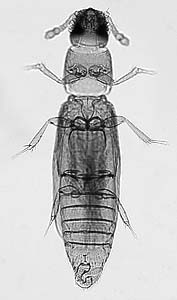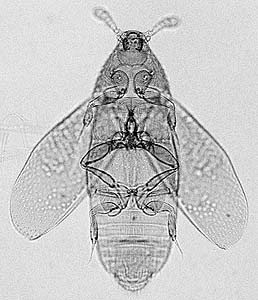Nanosellini
W. Eugene Hall- Nanosella
- Throscoptilium
- Porophila
- Suterina
- Hydnosella
- Cylindrosella
- Throscidium
- Mikado
- Kimoda
- Nellosana
- Kuschelidium
- Philagarica
- Isolumpia
- Paratuposa
- Mycophagus
Introduction
Nanosellini, tentatively composed of 15 genera and 27 species, is widely distributed throughout the world. The majority of species occur on or within fungi, usually of the Polyporaceae, feeding on fungal spores. Rarely will more than one species inhabit a particular host. Nanosellines are the smallest beetles known, ranging .30-.80 mm in total length.
Characteristics
The presence of contiguous metacoxae, mesosternal process, metasternal lines and dependence on a host fungus help separate Nanosellinae from other subfamilies within the Ptiliidae. Shape of the mesosternal process, length of metasternal lines and antennal segment number and morphology have proven to be useful characters when distinguishing nanoselline genera. As with all members of the Ptiliidae, variation of spermatheca design is critical to distinguish species.
Variation of nanoselline antennal segments (top to bottom: Throscidium, Nellosana, 'Poropholine', Cylindrosella)
Taxonomic History
The subfamily Nanosellinae was erected within the Ptiliidae by H.S. Barber (1924), based on a suite of morphological characters, plus dependence on fungal spores. Within this subfamily, Barber placed Cylindrosella, Mycophagus, Nanosella, and Throscoptilium.
Matthews (1872) described Throscidium from Chile. This genus is currently considered to be a primitive form of Nanosellinae. Matthews (1900) also described Mikado from Japan, noting its association with a host fungus.
Within Australia and associated geographic regions, Deane (1930, 1931) described Isolumpia, Philagarica and Paratuposa. Though no reference is made to Barber's classification, Deane's descriptions, illustrations and host records allow placement of these taxa within the subfamily.
Dybas (1956) described Porophila, presently the only nanoselline known from the West Coast of the United States. Dybas (1961) also described two genera from the Eastern United States, Hydnosella and Suterina (=Suterella). Both genera are considered to be atypical of the Nanosellinae, since neither is associated with a polypore fungus. Hydnosella has been collected on fungus of the Hydnaceae, while Suterina is found in forest leaf litter.
Johnson (1982) described Nellosana and Kuschelidium from New Zealand. Johnson (1985) also described Kimoda from islands of the Mascarenes, suggesting this genus may be allied to Mikado.
Discussion of Phylogenetic Relationships
As with all groups of featherwing beetles, a phylogenetic analysis of nanoselline relationships currently does not exist. Hall (1999) conducted a worldwide systematic revision of the Nanosellinae, and Mikael Sörensson (Zoological Institute, Lund) is performing a genus level phylogenetic analysis of the Ptiliidae as a whole.
Dybas (1976: 50) questioned the validity of the subfamily status of Nanosellinae, noting characters chosen by Barber "do not, in fact, serve to distinguish the group from other Ptiliidae", and may actually justify placement of the group within the Ptiliinae, giving nanosellines tribal ranking. However, Dybas did not propose a new system of classification, and within a recent classification of the Staphyliniformia (Newton and Thayer, 1992), Nanosellinae retains subfamily status.
Based on extensive morphological evidence, Hall (1999, 2000, 2005) and Sörensson (1997) have lowered the ranking of the group to the tribe Nanosellini within the subfamily Ptiliinae.
References
Barber, H.S. 1924. New Ptiliidae related to the smallest known beetle. Proc. Ent. Soc. Wash. 26 (6): 167-178.
Deane, C. 1930. Trichopterygidae of Australia and Tasmania. Proc. Linn. Soc. N.S.W. 55: 477-487.
Deane, C. 1931. Trichopterygidae of Australia and Adjacent Islands. Proc. Linn. Soc. N.S.W. 56: 237-242.
Dybas, H.S. 1956. A new genus of minute fungus-pore beetles from Oregon. Fieldiana. 34: 441-448.
Dybas, H.S. 1961. Two new genera of feather-wing beetles from the eastern United States. Fieldiana. 44 (2): 11-18.
Dybas, H.S. 1976. The larval characters of featherwing and limulodid beetles and their family relationships in the Staphylinoidea (Coleoptera: Ptiliidae and Limulodidae). Fieldiana:Zoology, 70 (3): 29-78.
Dybas, H.S. 1980. Suterina Dybas, replacement name for Suterella Dybas, preoccupied (Coleoptera: Ptiliidae). Coleopt. Bull. 34:261.
Hall, W. E. 1999. Generic revision of the tribe Nanosellini (Coleoptera: Ptiliidae: Ptiliinae). Transactions of the American Entomological Society 125 (1- 2): 39 - 126.
Hall, W. E. 2000. Ptiliidae Erichson, 1845, pp. 233-246. In: Arnett, R. H., Jr. and M. C. Thomas (eds.). 2000. American Beetles. Vol. 1. Archostemata, Myxophaga, Adephaga, Polyphaga: Staphyliniformia. CRC Press, Boca Raton, Florida. xv + 443 pp.
Hall, W. E. 2005. Ptiliidae. Pp. 251- 261 in R. G. Beutel and R.A.B. Leschen (eds.), Handbook of Zoology, Volume 4. Arthropoda: Insects: Part 38. Coleoptera, Beetles. Volume 1: Morphology and Systematics. De Gruyter, Berlin/New York.
Johnson, C. 1982. An introduction to the Ptiliidae (Coleoptera) of New Zealand. N.Z. Journ. Zool., 9 : 333-376.
Johnson, C. 1985. Revision of Ptiliidae (Coleoptera) occurring in the Mascarenes, Seychelles and neighboring islands. Entomologica Basiliensia, 10: 159-237.
Matthews, A. 1872. Trichopterygia illustrata et descripta.
Matthews, A. 1900. Trichopterygia illustrata et descripta. Supplement.
Newton, A.F. and M.K. Thayer. 1992. Current classification and family-group names in the staphyliniformia (Coleoptera). Fieldiana:Zoology, n.s., 67: 1-92.
Sörensson, M. 1997. Morphological and taxonomical novelties in the world' s smallest beetles, and the first Old World record of Nanosellini (Coleoptera: Ptiliidae). Systematic Entomology, 22: 257 – 283.
Title Illustrations

| Scientific Name | Cylindrosella dampfi |
|---|---|
| Location | Arizona |
| Image Use |
 This media file is licensed under the Creative Commons Attribution-NonCommercial-ShareAlike License - Version 3.0. This media file is licensed under the Creative Commons Attribution-NonCommercial-ShareAlike License - Version 3.0.
|
| Copyright |
© 1997

|
| Scientific Name | Suterina microcephala |
|---|---|
| Location | Florida |
| Image Use |
 This media file is licensed under the Creative Commons Attribution-NonCommercial-ShareAlike License - Version 3.0. This media file is licensed under the Creative Commons Attribution-NonCommercial-ShareAlike License - Version 3.0.
|
| Copyright |
© 1997

|
About This Page
Page copyright © 1997
 Page: Tree of Life
Nanosellini.
Authored by
W. Eugene Hall.
The TEXT of this page is licensed under the
Creative Commons Attribution-NonCommercial-ShareAlike License - Version 3.0. Note that images and other media
featured on this page are each governed by their own license, and they may or may not be available
for reuse. Click on an image or a media link to access the media data window, which provides the
relevant licensing information. For the general terms and conditions of ToL material reuse and
redistribution, please see the Tree of Life Copyright
Policies.
Page: Tree of Life
Nanosellini.
Authored by
W. Eugene Hall.
The TEXT of this page is licensed under the
Creative Commons Attribution-NonCommercial-ShareAlike License - Version 3.0. Note that images and other media
featured on this page are each governed by their own license, and they may or may not be available
for reuse. Click on an image or a media link to access the media data window, which provides the
relevant licensing information. For the general terms and conditions of ToL material reuse and
redistribution, please see the Tree of Life Copyright
Policies.
- Content changed 27 January 2007
Citing this page:
Hall, W. Eugene. 2007. Nanosellini. Version 27 January 2007 (under construction). http://tolweb.org/Nanosellini/9625/2007.01.27 in The Tree of Life Web Project, http://tolweb.org/














 Go to quick links
Go to quick search
Go to navigation for this section of the ToL site
Go to detailed links for the ToL site
Go to quick links
Go to quick search
Go to navigation for this section of the ToL site
Go to detailed links for the ToL site